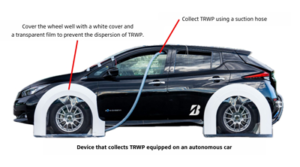Bridgestone develops cutting-edge tire and road wear particles collection method
Tokyo, Japan – Bridgestone Corporation has developed a cutting-edge Tire and Road Wear Particles (TRWP) vehicle collection method to understand the environmental impact of TRWP. These particles result from the friction between the tire and the road surface, which is essential for a safe, comfortable journey. TRWP consists of a mixture of tire tread and road pavement materials. Bridgestone is actively conducting various research activities to understand the particle size distribution, dispersion behavior, and environmental impact of TRWP, as well as to develop efficient collection methods. Through these efforts, the company is committed to both understanding and reducing TRWP generation.
Bridgestone aims to accelerate research and contribute to the understanding, solutions, and mitigation of TRWP’s environmental impact. The company has focused on how TRWP is generated, utilizing the B-Mobility proving ground at the Bridgestone Innovation Park in Kodaira, Tokyo. Bridgestone has developed a cutting-edge method that enables the efficient collection of TRWP. By combining a high-speed camera with laser light scattering, the company has visualized the dispersion of particles such as TRWP. Based on these findings, Bridgestone has created a device that covers the entire tire and captures TRWP efficiently. Furthermore, by utilizing autonomous driving and an electric vehicle with regenerative braking, the collection method eliminates the influence of exhaust emissions and brake dust.
Through its activities to understand TRWP, Bridgestone, as an industry leader, has been investigating the physical and chemical characteristics of TRWP and their environmental effects through the Tire Industry Project (TIP) under the World Business Council for Sustainable Development (WBCSD). By efficiently collecting TRWP at a high recovery rate through its newly developed collection method, Bridgestone is accelerating its efforts to assess TRWP’s environmental effects, in addition to ongoing co-creation and internal R&D collaboration.
In parallel with efforts to understand TRWP, Bridgestone is also promoting initiatives to reduce and minimize TRWP generation, such as developing long-life products with improved wear resistance and collaborating with its solutions business. Through these efforts, Bridgestone strives to achieve its corporate commitment, the “Bridgestone E8 Commitment,” which focuses on advancing sustainable tire technologies and solutions that preserve the environment for future generations.

